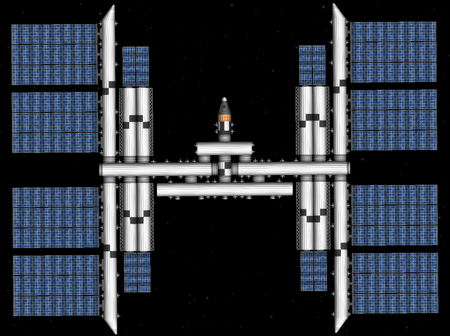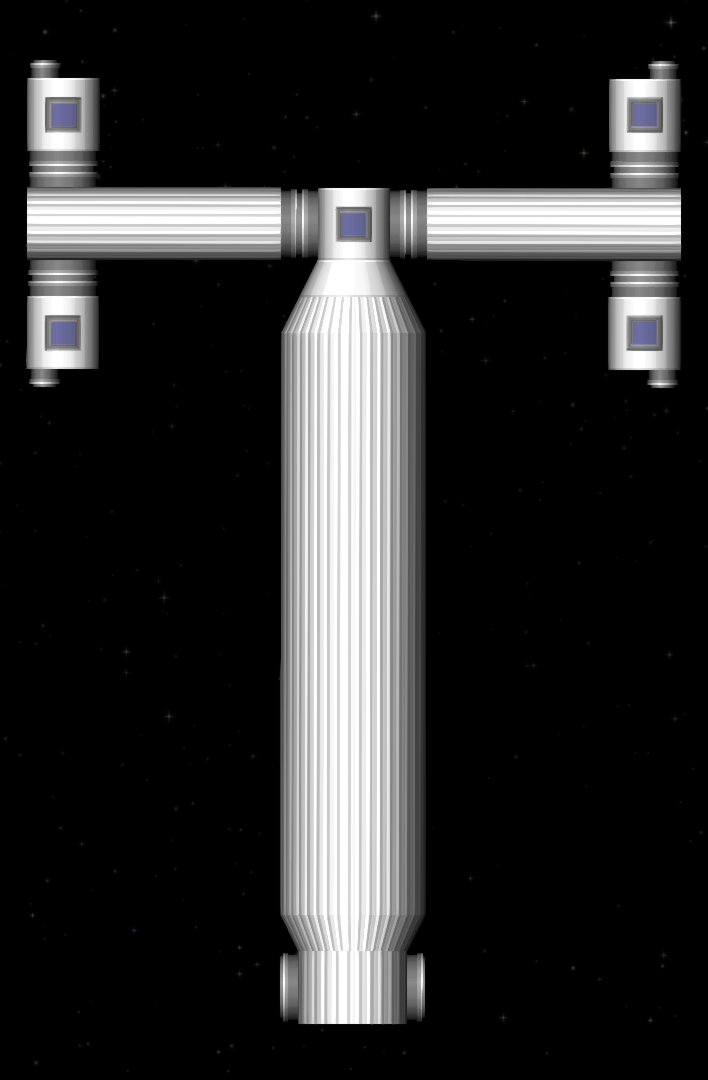Space Stations of the Shazbotdom Imperial Space Administration: Difference between revisions
Jump to navigation
Jump to search
m (→Crew) |
|||
| Line 17: | Line 17: | ||
! Project !! Head Scientist !! Head Scientist<br>in Orbit !! Total # of Scientists<br>in Project !! Percentage Complete | ! Project !! Head Scientist !! Head Scientist<br>in Orbit !! Total # of Scientists<br>in Project !! Percentage Complete | ||
|- | |- | ||
| Ongoing Cancer Research || Dr. Stephen E. Thompson || Yes || 2 || | | Ongoing Cancer Research || Dr. Stephen E. Thompson || Yes || 2 || | ||
|- | |||
| Research on Prolonged Time in Space || Dr. Armando E. Federicci || No || 0 || | |||
|- | |- | ||
| New Vaccine, set to be useful against 10+ viruses || Dr. Vivian D. Moorston || Yes || 2 || 65% | | New Vaccine, set to be useful against 10+ viruses || Dr. Vivian D. Moorston || Yes || 2 || 65% | ||
|- | |||
| Microbe Experimentation || Dr. Sandera D. Livingston || No || 0 || 0% | |||
|}</center> | |}</center> | ||
Revision as of 22:34, 24 August 2023
Below is the complete list of Space Stations for the Shazbotdom Imperial Space Administration.
Orbital Science Space Station
- The Orbital Science Space Station is the primary orbital laboratory for the Shazbotdom Imperial Space Agency. most of the Scientific Research on this station is for Scientific and Medical reasons, with such things as Cancer Research, experimental Biomedical Mesh system for replacement of body parts, as well as many other things. The Empire is opened up to having Scientists from friendly nations to be sent up to the space station to assist in, or bring up their own, research projects.
Crew Capacity
- As it currently stands, the Space Station has enough living quarters for up to 20 Scientists at a maxiumum, but can be operated with a minimum of 5 to 7 Scientists. Each Scientist will be in orbit for a minimum of 3 months, but can be up for a maxiumum of 19 months. This is due to equipment on the station that will allow them to get in a workout regiment to ensure minimal loss of muscle mass.
Research Projects
Current Research Projects include the following:
| Project | Head Scientist | Head Scientist in Orbit |
Total # of Scientists in Project |
Percentage Complete |
|---|---|---|---|---|
| Ongoing Cancer Research | Dr. Stephen E. Thompson | Yes | 2 | |
| Research on Prolonged Time in Space | Dr. Armando E. Federicci | No | 0 | |
| New Vaccine, set to be useful against 10+ viruses | Dr. Vivian D. Moorston | Yes | 2 | 65% |
| Microbe Experimentation | Dr. Sandera D. Livingston | No | 0 | 0% |
Finished Research Projects
| Project | Head Scientist | Completed |
|---|---|---|
| New Polimer, set to be 10x stronger than glass | Dr. Anders E. Belleroy | Yes |
| Testing of new Hydroponics Equipment, will give higher crop yields for Space Travel | Dr. Anthony Spock | Yes |
Manufacture and Assembly
- Manufacture of the various segments of the O.S.S.S. was done at a total of 6 facilites across the Empire and those segments were shipped to the George A. Loak Memorial Space Station, where they were held in a large storage building until it was their turn in the launch sequence. The launching of the segments began on the 15th of July, 2022 and the last segment, the Command Module, was launched on the 23rd if August, 2022 and docked in its location at the very top of the facility 7 hours later after 3 orbital burn adjustments before the final burn close to the station for final alignment and dockng. It took a total of 13 Launches to complete the assembly of the Space Station to the point it is today. A 14th Launch is currently Scheduled to replace the Docking Module for a new segment that will include 5 Docking Ports for the v2 Orbiter. Docking for the Cargo Transporters will be moved to the Tertiary Docking Ports along the Solar PanelArray segments on either side of the Space Station.
High Orbital Transfer Station
- Currently under construction, this station will assist in the transfer of crews to and from Earth to the future Colonial Holdings on Venus and Mars, as soon as those facilities are built. There is no expected completion date as it is a work in progress and will most likely have parts added onto it over the years after the completion date, to the point in which the H.O.T.S. will never be completed in the traditional sense, and may even become a permanant high orbital colonial holding if necessary.
Crew
- As of right now, it is planned for a rotation crew compliment of roughly 30 individuals to ensure that the systems of the H.O.T.S. continue to operate at maxiumum capacity, with temporary lodging for up to 100 individuals for the transfer process for the missions to the Luna, Venus, and Mars. These numbers may change with the expansion of the station to ensure optimal operation of the facilities into the future.
The Building Process
- Currently, most of the sections for the Space Station will be launched into orbit utilizing the Low to Mid Orbit Launch System. The larger section, such as the upcomming launch of the Solar Panel Arrays, will utilize the HLS System to get those large parts to orbit and docked with the station. As of right now, a total of 7 Sections have been launched on 4 Missions.
Transfer Destinations
As it stands, there are only two Secondary Transfer Stations planned to be built outside of the Earth Orbit.
Mars Orbital Transfer Station
- Slated to begin transfer of pieces into orbit in late 2023, the Mars Orbital Transfer Station will be utilized as the final stopping point for Colonists to be transported to the Martian Surface. It's main purpose is to load the last final amount of propellant that will be utilized by the Stage 2 Block 4 Booster to make it's descent to the Martian surface. It will also be utilized as the first stop after leaving the Martian Surface for any ships returning to Earth.
Venus Orbital Transfer Station
- Slated to begin transfer of pieces into orbit in mid 2024, the Venus Orbital Transfer Station will be utilized as the final stopping point for Colonists to be transported to the Surface of Venus. It's main purpose is to load the last final amount of propellant that will be utilized by the Stage 2 Block 4 Booster to make it's descent to the Martian surface. It will also be utilized as the first stop after leaving the Martian Surface for any ships returning to Earth.
Lunar Orbit Crew Transfer Station
Construction
- The Lunar Orbit Crew Transfer Station (L.O.C.T.S.) is a remarkable feat of engineering that took five launches to complete. Situated in the orbit around the Moon, L.O.C.T.S serves as a vital hub for Human Exploration and Colonization on the moon.
- The construction of L.O.C.T.S began with the first launch, which carried the primary hallway to establish a foundation. The primary module, known as the Core, formed the backbone of the station. It houses life support systems, communication equipment, and the control center. Additionally, the launch included the primary docking ports, where the Stage 2 Block 4 Boosters launched from the Empire will dock.
- The second and third launches focused on adding the two Secondary Docking Arms, where the four Lunar Landers were to dock when they were not in use bringing colonists down to the Lunar Surface. The modules attached to the Core provided quick transfer from the Two Primary Docking Ports to the Four Secondary Ports. The fourth and fifth launches added two Temporary Engine Modules to the superstructure bottom. These Two Engines were utilized to ascend the entire Transfer Station into Lunar Orbit, where it would sit, ready to be used.
- The building of the L.O.C.T.S. was a monumental achievement. It represented the culmination of years of planning, engineering, and collaboration between nations. The station's completion marked a significant milestone in human space exploration, as it provided a platform for further research, technological development, and potential future missions to other celestial bodies.
- The Lunar Orbit Crew Transfer Station, with its five successful launches, stands as a testament to human ingenuity and our relentless pursuit of knowledge. It serves as a beacon of hope for the future of space exploration, inspiring generations to come to reach for the stars and unravel the mysteries of the universe.
Crew
- The Station does not utilize a crew as per say. It's primary control is done by remote control from the primry servers at Imperial Space Administration Headquarters in the Imperial City of Joliet. At any one point in time, there is a crew of 4 manning the varried systems of the Crew Transfer Station in the primary control room.

